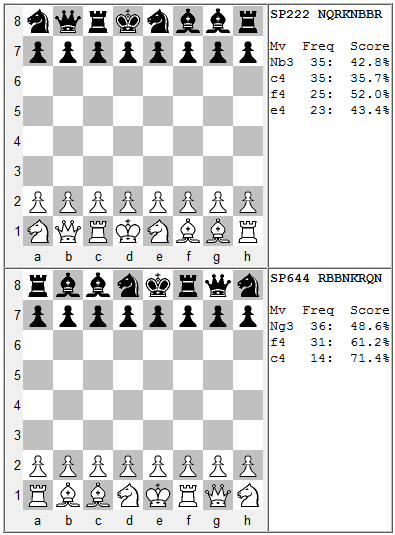SP222 NQRKNBBR has [an average success rate for White (%W)] of only 43.3%, while its twin, SP644 RBBNKRQN, has %W of 59.8%.
Is this a statistical fluke or is there an underlying reason? I noted,
Four of the five twins with the largest difference in %W have one SP in the pair where castling is possible on the first move. This indicates that the ability to castle quickly is an important defensive strategy in a difficult position.
After posting those observations, I noticed that the four pairs of twins didn't support my conclusion. Where castling was possible on the first move, White had a significantly better score in two of the pairs, while Black was better in the other two. I decided to take a closer look at the twins from my example, SP222 and SP644.
The following table shows some basic information for the two SPs. The column on the right shows the most frequent first moves for each SP along with each move's score for White. For example, in SP222 the move 1.Nb3 was played 35 times and scored 42.8% for White; in SP644 the equivalent move 1.Ng3 was played 36 times and scored 48.6% for White. The two Knight moves appear to affect their respective SPs in the same way.

I doubt that the difference between SP222's 1.Nb3 score of 42.8% and SP644's 1.Ng3 score of 48.6% is statistically significant. A more promising investigation would be SP222's 1.c4 score of 35.7% and SP644's 1.f4 score of 61.2%. Both first moves involve pushing the Pawn in front of a Rook. It so happens that the chosen Pawn is relevant to the position of the castled King on that side.
In SP222, the move 1.c4 weakens an eventual O-O-O; in SP644, the move 1.f4 makes space for the Rook after an eventual O-O. Is that the reason for the difference in scores for White? More investigation is required to answer that question.

1 comment:
Considering Http URL...
http://www.chesscafe.com/text/ebcafe02.pdf
(2012/Dec/16)
How to Play Against 1 e4
by Neil McDonald
{
... struck me while writing this book:
ii. How often the black king should (and does) stay in the centre in the French Defence. Many years ago the great World Champion Emanuel Lasker suggested that the right to castle should be abandoned in order to allow more attacking chess to be played. Capablanca (or perhaps Réti) replied that without the castling rule, White's right to move first would give him too much advantage.
}
Chess960-FRC has lots of start setups in which castling is significantly less compelling than in the one traditional setup (wherein castling heavily dominates other options, and just to the h-wing at that).
In some FRC setups, castling is less attractive because the structure of the post-castling multi-piece "castle" (or "fort"?) is less safe than the standard post-castling structure of the traditional setup.
But in other FRC setups the same types of reasons against castling exist as McDonald says exist in the traditional French Defense.
If the chess world wants to better understand this facet of traditional chess, and of abstract chess (these pieces on this board), study of castling in a variety of chess960 setups is almost certainly the best way to achieve that better understanding.
GeneM
CastleLong.com
Post a Comment